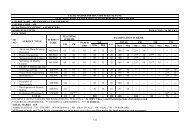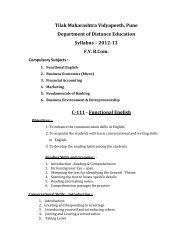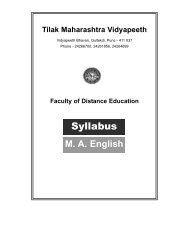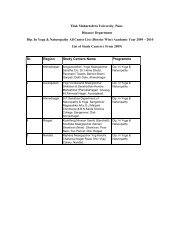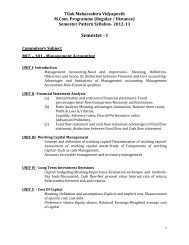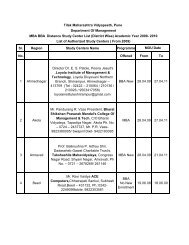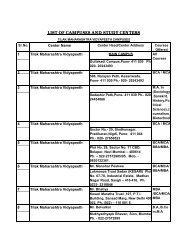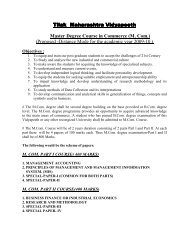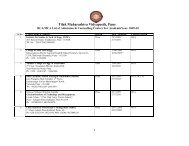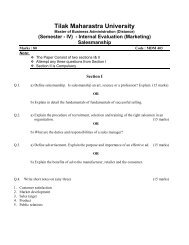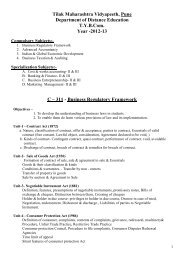Third Semester - Curriculam - Tilak Maharashtra Vidyapeeth
Third Semester - Curriculam - Tilak Maharashtra Vidyapeeth
Third Semester - Curriculam - Tilak Maharashtra Vidyapeeth
Create successful ePaper yourself
Turn your PDF publications into a flip-book with our unique Google optimized e-Paper software.
TILAK MAHARASTRA VIDYAPEETH, PUNE<br />
TEACHING AND EXAMINATION SCHEME FOR DIPLOMA COURSE<br />
COURSE NAME : DIPLOMA IN ELECTRONICS AND TELECOMMUNICATION ENGINEERING<br />
COURSE CODE : ET<br />
DURATION OF COURSE : 6 SEMESTERS<br />
SEMESTER : THIRD DURATION: 16 WEEKS<br />
FULL TIME<br />
SR.<br />
NO.<br />
SUBJECT TITLE<br />
SUBJECT<br />
CODE<br />
TEACHING<br />
SCHEME<br />
TH<br />
PR<br />
PAPER<br />
HRS<br />
EXAMINATION SCHEME<br />
TH<br />
TH PR OR TW<br />
INT<br />
Max Min Max<br />
1 Mathematics-III ET3001 04 -- 03 80 32 20 100 40 -- -- -- -- -- --<br />
2 Basic Electronics ET3002 04 02 03 80 32 20 100 40 50** 20 -- -- -- --<br />
3 Electrical Technology ET3003 04 02 03 80 32 20 100 40 -- -- -- -- 25* 10<br />
4<br />
5<br />
Principles of Digital<br />
Techniques<br />
Instrumentation &<br />
Measurements<br />
ET3004 04 02 03 80 32 20 100 40 -- -- -- -- 25* 10<br />
ET3005 04 02 03 80 32 20 100 40 -- -- 25** 10 25* 10<br />
6 Programming in ‘C’ ET3006 01 02 -- -- -- -- -- -- 50** 20 -- -- -- --<br />
7 Professional Practices-II ET3007 -- 02*** -- -- -- -- -- -- -- -- -- -- 50* 20<br />
8 Communication Skills ET3011 03 02*** 03 80 32 20 100 40 -- -- -- -- -- --<br />
TOTAL 24 14 -- 480 -- 120 600 -- 100 -- 25 -- 125 --<br />
STUDENT CONTACT HOURS PER WEEK (FORMAL TEACHING): 38HRS: Theory and practical Periods of 60 minutes each.<br />
* - INTERNAL ASSESSMENT , ** - EXTERNAL ASSESSMENT, ***-TUTORIAL<br />
TOTAL MARKS – 850<br />
ABBREVIATIONS : TH – THEORY,INT-INTERNAL, PR – PRACTICALS , OR –ORAL, TW – TERMWORK<br />
All Practical, Orals & Term work assessments are to be done as per the prevailing curriculum implementation & assessment norms.<br />
56
COURSE NAME : DIPLOMA IN ELECTRONICS &<br />
TELECOMMUNICATION ENGINEERING<br />
SEMESTER<br />
: THIRD<br />
SUBJECT TITLE : MATHEMATICS-III<br />
SUBJECT CODE : ET3001<br />
TEACHING AND EXAMINATION SCHEME:<br />
Teaching Scheme<br />
Examination Scheme<br />
TH PR<br />
PAPER<br />
TH INT PR OR TW TOTAL<br />
HRS<br />
04 -- 03 80 20 -- -- -- 100<br />
Pre-requisites: The student must know the following concepts:<br />
1. Factorization of polynomials<br />
2. Limits, Derivatives.<br />
3. Formulae of factorization & expansion.<br />
4. Factorization and de-factorization formulae of Trigonometry.<br />
5. Formulae of Binomial Theorem.<br />
6. Rules of algebraic expressions for the numbers with positive & negative<br />
signs.<br />
7. Functions and their types.<br />
Objectives: The student will be able to<br />
1. Apply Mathematical term, concept, principles, and different methods.<br />
2. Apply Mathematical methods to solve technical problems.<br />
3. Use Mathematical techniques necessary for daily and practical problems.<br />
57
Subject Title: MATHEMATICS-III<br />
Subject Code: ET3001<br />
Contents: Theory<br />
Unit Name of the Topic Hours Marks<br />
01 INTEGRATION<br />
12 24<br />
Definition of integration as anti-derivative. Integration<br />
of standard function.<br />
Rules of integration (Integrals of sum, difference, scalar<br />
multiplication).<br />
Methods of Integration:<br />
• Integration by substitution<br />
• Integration of rational functions<br />
• Integration by partial fraction<br />
• Integration by trigonometric transformation<br />
• Integration by parts<br />
Definite Integration: Definition of definite integral,<br />
Properties of definite integral with simple problems.<br />
Applications of definite integrals:<br />
• Area under the curve<br />
• Area between two curves<br />
• Mean and RMS values<br />
02 DIFFERENTIAL EQUATION<br />
10 16<br />
Definition of differential equation, order and degree of<br />
differential equation. Formation of differential<br />
equation for function containing single constant.<br />
Solution of differential equations of first order and first<br />
degree such as variable separable type, reducible to<br />
Variable separable, Homogeneous, Nonhomogeneous,<br />
Exact, Linear and Bernoulli equations.<br />
Applications of Differential equations.<br />
Laws of voltage and current related to LC, RC, and RLC<br />
Circuits.<br />
03 LAPLACE TRANSFORM<br />
08 16<br />
Definition of Laplace transform, Laplace transform of<br />
standard functions.<br />
Properties of Laplace transform such as Linearity, first<br />
shifting, second shifting, multiplication by t n division by t.<br />
Inverse Laplace transforms. Properties- linearly first<br />
shifting, second shifting. Method of partial fractions.<br />
Convolution theorem.<br />
Laplace transform of derivatives.<br />
Solution of differential equation using Laplace transform<br />
(up to second order equation).<br />
04 FOURIER SERIES<br />
Definition of Fourier series (Euler’s formula).<br />
Series expansion of continuous functions in the<br />
intervals( 0,2 l) ,( −l, l) ,( 0,2 π ),( − ππ , ) .<br />
Series expansions of even and odd functions, Half range<br />
series.<br />
08 08<br />
58
05 NUMERICAL METHODS<br />
05 08<br />
Solution of algebraic equations:<br />
• Bisection method.<br />
• Regularfalsi method<br />
• Newton – Raphson method<br />
Solution of simultaneous equations containing 2 and 3 05 08<br />
unknowns:<br />
• Gauss elimination method<br />
• Iterative methods – Gauss-Seidal and Jacobi’s<br />
methods<br />
TOTAL 48 80<br />
Recommended Books:<br />
Sr. No Title Author Publisher<br />
Pune Vidyarthi<br />
01 Mathematics for polytechnic S. P. Deshpande Griha Prakashan,<br />
Pune<br />
02 Calculus: single variable Robert T. Smith Tata McGraw Hill<br />
03 Laplace Transform Lipschutz<br />
Schaum outline<br />
series.<br />
04<br />
05<br />
06<br />
07<br />
Fourier series and boundary<br />
value problems<br />
Higher Engineering<br />
Mathematics<br />
Introductory Methods of<br />
Numerical analysis<br />
Numerical methods for<br />
scientific & engineering<br />
computations<br />
Brown<br />
B. S. Grewal<br />
S. S. Sastry<br />
M. K. Jain & others<br />
Tata McGraw Hill<br />
Khanna<br />
Publication, New<br />
Dehli<br />
Prentice Hall Of<br />
India, New Dehli<br />
Wiley Eastern<br />
Publication.<br />
59
COURSE NAME<br />
COURSE CODE<br />
SEMESTER<br />
SUBJECT TITLE<br />
SUBJECT CODE<br />
: DIPLOMA IN ELECTRONICS &<br />
TELECOMMUNICATION ENGINEERING<br />
: ET<br />
: THIRD<br />
: BASIC ELECTRONICS<br />
: ET3002<br />
TEACHING AND EXAMINATION SCHEME:<br />
Teaching Scheme<br />
Examination Scheme<br />
TH PR<br />
PAPER<br />
TH INT PR OR TW TOTAL<br />
HRS<br />
04 02 03 80 20 50** -- -- 150<br />
Pre-requisites: The student must know the following concepts:<br />
1. Basics of Semiconductors<br />
2. P-type & N-type Semiconductors<br />
3. Classification of Semiconductors & comparison between Semiconductor,<br />
Insulators & Conductors.<br />
4. Concept of diode & formation of PN Junction.<br />
Objectives: The student will be able to<br />
1. Define Diode & classify it.<br />
2. Define rectification & give its types.<br />
3. Define Transistors & types of transistors.<br />
4. Classify small signal amplifiers.<br />
5. Define regulation & explain its need.<br />
6. Analyze concept of power control circuit.<br />
7. Define transducers & classify them.<br />
60
Subject Title: BASIC ELECTRONICS<br />
Subject Code: ET3002<br />
Contents: Theory<br />
Unit Name of the Topic Hours Marks<br />
01 SEMICONDUCTOR DIODE<br />
08 14<br />
Rectifying diode<br />
Review of P-type and N-type semiconductor<br />
Junction of P-type & N-type i.e. P-N junction, Barrier<br />
voltage, depletion region, Junction Capacitance<br />
Forward biased & Reversed biased junction.<br />
Diode symbol, circuit diagram for characteristics<br />
(forward & reversed).<br />
Characteristics of PN junction diode.<br />
Specifications: Forward voltage drop, Reversed<br />
saturation current, maximum forward current, power<br />
dissipation.<br />
Package view of diodes of different power ratings (to<br />
be shown during practical hours).<br />
Zener diode: Construction (reference to doping level).<br />
Symbol, circuit diagram for characteristics (forward &<br />
reversed).<br />
Avalanche & zener breakdown.<br />
Specifications: Zener voltage , power dissipation ,<br />
break over current, dynamic resistance & maximum<br />
reverse current.<br />
Special diodes: Point contact diode , Schottkey diode.<br />
Optical Diodes: LED, IRLED, photo diode, and laser<br />
diode.<br />
Symbol, operating principle & applications of each.<br />
02 RECTIFIERS & FILTERS<br />
Need of rectifier, definition.<br />
Types of rectifiers: Half wave rectifier, Full wave<br />
rectifier (Bridge & centre tapped).<br />
Circuit operation.<br />
Input/output waveforms for voltage & current, Average<br />
(DC) value of current & voltage (no derivation).<br />
Ripple, ripple factor, ripple frequency, PIV of diode<br />
used, transformer utilization factor, efficiency of<br />
rectifier.<br />
Comparison of three types of rectifiers.<br />
Need of filters.<br />
Types of filters:<br />
08 16<br />
• Shunt capacitor<br />
• Series inductor<br />
• LC filter<br />
• π filter<br />
Circuit operation, DC output voltage, ripple factor<br />
(formula), ripple frequency, Dependence of ripple<br />
factor on load.<br />
Input/output waveforms, limitations & advantages.<br />
61
03 TRANSISTORS<br />
Bipolar junction transistor (BJT):<br />
Introduction, Basic concept.<br />
Types of transistors, structure & symbols, Transistor<br />
operation.<br />
Conventional current flow, relation between different<br />
currents in transistor.<br />
Transistor amplifying action.<br />
Transistor configurations: CB, CE & CC.<br />
Circuit diagram to find the Input/output characteristics.<br />
Transistor parameters: input resistance, output<br />
resistance, α , β & relation between them.<br />
Comparison between three configurations.<br />
Transistor specifications: V CE Sat , I C Max, V CEO , I CEO, α , β<br />
V CE Breakdown , Power dissipation (to be explained during<br />
practical using data sheets).<br />
Testing of transistor using multimeter (to be shown<br />
during practical).<br />
Construction, working principle, characteristics of<br />
Photo-transistor.<br />
Introduction to opto-coupler<br />
Unipolar transistor (JFET):<br />
Construction, working principle & characteristics.<br />
Unijunction Transistor(UJT):<br />
Construction, working principle & characteristics<br />
04 BIASING OF BJT<br />
Introduction, need of biasing, concept of dc load line,<br />
selection of operating point (Q point), need of<br />
stabilization of Q point (thermal run away concept).<br />
Types of biasing circuits:<br />
• Fixed biased circuit<br />
• Base biased with emitter feedback<br />
• Base biased with collector feedback<br />
• Voltage divider<br />
• Emitter biased<br />
Circuit operation of each circuit.<br />
Introduction to two port n/w.<br />
Hybrid model for CE.<br />
05 REGULATED POWER SUPPLY<br />
What is a regulator<br />
Need of regulators. Voltage regulation factor.<br />
Concept of load regulation & line regulation.<br />
Basic zener diode voltage regulator.<br />
Linear Regulators: Basic block diagram of DC power<br />
supply.<br />
Transistorized series & shunt regulator: Circuit diagram<br />
& operation.<br />
Regulator IC’s:78xx, 79xx, 723 as fixed, variable &<br />
dual regulator.<br />
08 18<br />
08 12<br />
08 10<br />
62
06 SMALL SIGNAL AMPLIFIERS<br />
08 10<br />
Concept of amplification.<br />
Small signal amplifier using BJT.<br />
Graphical analysis.<br />
Determination of current, voltage & power gain, Input<br />
& output resistance, phase shift between input &<br />
output.<br />
AC Load Line.<br />
Function of input & output coupling capacitors &<br />
criteria for the value selection.<br />
Function of emitter bypass capacitor & its value<br />
selection.<br />
AC equivalent circuit of transistor CE amplifier.<br />
Single stage CE amplifier with voltage divider bias.<br />
Its explanation.<br />
TOTAL 48 80<br />
Practical:<br />
Skills to be developed<br />
Intellectual skills:<br />
1. Identification and selection of components.<br />
2. Interpretation of circuits.<br />
3. Understand working of Regulated dc power supply.<br />
Motor skills:<br />
1. Ability to draw the circuits.<br />
2. Ability to measure various parameters.<br />
3. Ability to test the components using multimeter.<br />
4. Follow standard test procedures.<br />
List of Practical: (Any 9 to be performed)<br />
1. VI characteristics of diode<br />
2. VI characteristics of Zener diode<br />
3. Study of Rectifiers a] Half wave b] Full wave<br />
4. Study of filter circuits. a] Capacitor Filter b] Inductor filter.<br />
5. Input & output characteristics of transistor in CE mode<br />
6. Input & output characteristics of transistor in CB mode<br />
7. Characteristics of FET<br />
8. Characteristics of UJT<br />
9. Zener Diode Regulator<br />
10. Transistor series and shunt regulator<br />
11. Single stage common emitter amplifier<br />
12. Study of DC Regulated Power Supply<br />
63
Recommended Books:<br />
Sr. No. Author Title Publisher<br />
01<br />
N.N. Bhargava, D.C. Kulashreshtha, Basic Electronics & Tata McGraw<br />
S.C. Gupta - TTTI Chandigharh Linear Circuits<br />
Hill<br />
02<br />
Alberrt Malvino<br />
Electronic Principles Tata McGraw<br />
David J.Bates<br />
Hill<br />
03<br />
Allen Mottershead<br />
Electronic Devices & Prentice Hall<br />
Components’<br />
of India<br />
04<br />
Grob Bernard Basic Electronics Tata McGraw<br />
Hill<br />
05<br />
David J. Bell<br />
Electronics Devices & Prentice Hall<br />
Circuits<br />
of India<br />
64
COURSE NAME :<br />
COURSE CODE<br />
SEMESTER<br />
SUBJECT TITLE<br />
SUBJECT CODE<br />
DIPLOMA IN ELECTRONICS &<br />
TELECOMMUNICATION ENGINEERING<br />
: ET<br />
: THIRD<br />
: ELECTRICAL TECHNOLOGY<br />
: ET3003<br />
TEACHING AND EXAMINATION SCHEME:<br />
Teaching Scheme<br />
Examination Scheme<br />
TH PR<br />
PAPER<br />
TH INT PR OR TW TOTAL<br />
HRS<br />
04 02 03 80 20 -- -- 25* 125<br />
Pre-requisites: The student must know the following concepts:<br />
1. Basics of atomic theory.<br />
2. Concept of active & passive devices.<br />
3. Concept of voltage source & current source.<br />
4. Series & parallel circuits.<br />
Objectives: The student will be able to:<br />
1. Classify different types of circuits (series, parallel, networks etc).<br />
2. Classify networks and concepts of all Network Theorems.<br />
3. Compare A.C & D.C and all its parameters.<br />
4. Concept of resonance & types of resonance circuits.<br />
5. Classify & compare single phase & three phase circuits.<br />
6. Define transformer & classify it.<br />
7. Define Motor, explain principle of operation of all DC motors and also<br />
compare them on the basis of their characteristics.<br />
8. Explain concept of universal motor.<br />
65
Subject Title: ELECTRICAL TECHNOLOGY<br />
Subject Code: ET3003<br />
Contents: Theory<br />
Unit Name of the Topic Hours Marks<br />
01 D. C. CIRCUITS<br />
05 08<br />
Review of introduction to electricity - current, resistance, emf<br />
and potential difference, Ohm’s law, D.C. sources, series and<br />
parallel circuit.<br />
Concept of open and short circuit.<br />
Kirchoff’s current and voltage law.<br />
Maxwell’s loop current method.<br />
Node analysis.<br />
Concept of ideal and practical current and voltage sources,<br />
Source conversion.<br />
Star / Delta and Delta / star conversion (no derivation)<br />
(Numericals on above).<br />
02 NETWORK THEOREMS<br />
Network terminology – active, passive, linear, non-linear,<br />
bilateral, unilateral networks<br />
Statement, explanation and application of the following<br />
network theorems (DC circuits only):<br />
• Superposition theorem<br />
• Thevenin’s theorem<br />
• Norton’s theorem<br />
• Maximum power transfer theorem<br />
Concept of duality and construction of dual network.<br />
03 A.C. FUNDAMENTALS<br />
Difference between AC and DC quantity.<br />
Advantages of AC over DC.<br />
Waveform of sinusoidal AC cycle.<br />
Generation of single phase AC by elementary alternator.<br />
Definitions: instantaneous value, cycle, amplitude, time<br />
period, frequency, angular frequency, RMS value, Average<br />
value for sinusoidal waveform, Form factor, Peak factor (no<br />
derivation but simple numerical on it).<br />
Vector representation of sinusoidal AC quantity, review of<br />
phasor algebra, representation of AC quantity in rectangular<br />
and polar form.<br />
Phase angle, phase difference, concept of lagging and leading<br />
– by waveforms, mathematical equations and phasors.<br />
Pure resistance in AC circuit: waveforms, equations and vector<br />
diagram (no derivation).<br />
Pure inductance in AC circuit: waveforms, equations and<br />
vector diagram (no derivation).<br />
Pure capacitance in AC circuit: waveforms, equations and<br />
vector diagram (no derivation).<br />
Concept of impedance and impedance triangle.<br />
Power – active, reactive and apparent, power triangle.<br />
Power factor and its significance.<br />
R-L series circuit – vector diagram, voltage and current<br />
equations.<br />
R-C series circuit – vector diagram, voltage and current<br />
equations.<br />
66<br />
05 10<br />
06 08
R-L-C series circuit – vector diagram, voltage and current<br />
equations.<br />
Simple numerical on R-L, R-C and R-L-C series circuit.<br />
Concept of parallel A.C. circuit.<br />
Concept of admittance, conductance and susceptance (no<br />
numerical on parallel A.C. circuits).<br />
04 RESONANCE<br />
Resonance in RLC series circuit.<br />
Graphical representation of resonance curve.<br />
Resonant frequency, bandwidth and Q factor of series resonant<br />
circuit.<br />
Resonance in parallel circuit.<br />
Resonant frequency and Q factor, nature of resonance curve<br />
(no derivation and numerical).<br />
05 POLYPHASE CIRCUITS<br />
Advantages of 3 phase system over single phase system.<br />
Principle of 3-phase emf generation and its wave form.<br />
Concept of phase sequence and balanced and unbalanced load.<br />
Relation between phase and line current, phase and line<br />
voltage in Star connected and Delta connected balanced<br />
system. (no derivation).<br />
Calculation of current, power, power factor in a 3 phase<br />
balanced system (simple numerical).<br />
06 TRANSFORMER<br />
Working principle of transformer, classification, brief<br />
description of each part its function and material used.<br />
EMF equation (no derivation).<br />
Voltage ratio, current ratio and transformation ratio<br />
kVA rating of a transformer.<br />
Losses in a transformer.<br />
Efficiency and regulation of transformer - definition, equation<br />
and simple numerical on it.<br />
Condition for maximum efficiency (no derivation).<br />
Auto transformer – comparison with two winding transformer,<br />
applications, polarity markings.<br />
07 DC MOTORS<br />
Review of force on current carrying conductor, Fleming’s left<br />
hand rule.<br />
Construction – brief description of each part its function and<br />
material used.<br />
Principle of operation.<br />
Significance of back emf,<br />
Types of DC motors.<br />
Torque equation (expression only, no derivation).<br />
Schematic diagram, characteristics and applications of DC<br />
shunt, series and compound motors.<br />
Necessity of starter. Reversal of rotation of DC motor<br />
08 SINGLE PHASE INDUCTION MOTORS<br />
Construction and principle of working.<br />
Types: Squirrel cage and slip ring<br />
Synchronous speed, slip speed, slip and rotor frequency (no<br />
numerical).<br />
04 08<br />
05 08<br />
05 08<br />
05 10<br />
03 06<br />
67
Torque-speed characteristics.<br />
Necessity of starter.<br />
Speed control methods –brief description only.<br />
Reversal of rotation of 3 phase induction motor<br />
09 FRACTIONAL HORSE POWER (FHP) MOTORS<br />
04 08<br />
Universal motor: principle of operation, reversal of rotation<br />
and applications.<br />
Stepper motor: types, principle of working and applications.<br />
Servo motor: types, principle of working and applications.<br />
Synchronous motor<br />
10 INDUSTRIAL APPLICATIONS<br />
02 02<br />
Advantages of electric motor.<br />
Classification of electric drives.<br />
Selection of motor.<br />
Electrical Characteristics of motor.<br />
11 ELECTRICAL SAFETY AND COSTS<br />
04 04<br />
Tariff & Power conservation.<br />
Necessity of earthing, its types.<br />
Safety tools, first aid measures.<br />
Types of tariff.<br />
Methods of PF improvement.<br />
Energy conservation & audit.<br />
Fire extinguishing methods adopted in electrical engineering.<br />
TOTAL 48 80<br />
Practical:<br />
Skills to be developed<br />
Intellectual skills:<br />
1. Identify various types of machines<br />
2. Select instruments for measurement of electrical parameters and their ranges<br />
Motor skills:<br />
1. Draw machine characteristic<br />
2. Make proper connection<br />
3. Take measurements accurately<br />
A) List of Practical:<br />
1. Verification of Kirchoff’s laws.<br />
2. Verification of any one of the following network theorems<br />
I. Superposition theorem II. Thevenin’s theorem<br />
68
III. Norton’s theorem IV. Maximum power transfer theorem<br />
(Note – Select different theorem for different groups of students)<br />
3. To plot charging curve of capacitor through resistance and to determine the time<br />
constant.<br />
4. To observe sinusoidal A.C. waveform of any frequency on C.R.O. and to determine<br />
its frequency, time period, peak value, rms value, peak factor and form factor.<br />
5. To draw vector diagram and to determine power factor of R-L-C series circuit.<br />
6. To determine the relationship between line and phase values in three phase balanced<br />
star or delta connected load.<br />
7. To determine transformation ratio of single phase transformer and<br />
to perform polarity test on single phase transformer.<br />
8. To determine % efficiency and % regulation of a single phase transformer by direct<br />
loading.<br />
9. Study of any one DC motor in your laboratory. Write a report based on the<br />
following points.<br />
• Rating (Specification)<br />
• Foundation arrangement<br />
• Supply arrangement<br />
• Continuity and insulation test<br />
• Identification of its terminals<br />
• Sketch different parts and state the function of each part in brief<br />
Observe the direction of rotation reverse it.<br />
10. To determine % slip of Single phase induction motor and to reverse its direction of<br />
rotation.<br />
B) Field work / Mini Project:<br />
1. There are many electric devices / machines / equipment available in the market.<br />
Select any one device which is not included in your syllabus and prepare a short<br />
power point presentation for the class about how it works its features, cost,<br />
connections etc.<br />
2. Search the web site www.howstuffworks.com and learn the basics of electricity,<br />
principle of working of motors and generators etc.<br />
69
Utilize professional practice periods for this work.<br />
Recommended Books:<br />
Sr. No. Title Author Publisher<br />
01 Basic Electrical Engineering Mittle and Mittal<br />
Tata McGraw Hill, New<br />
Delhi<br />
02<br />
Electrical Technology Vol – I<br />
S. Chand Publications,<br />
B. L. Theraja,<br />
and II<br />
Delhi<br />
03 Circuit Analysis Soni, Gupta<br />
Dhanpat Rai and sons New<br />
Delhi<br />
70
COURSE NAME<br />
SEMESTER<br />
COURSE CODE<br />
SUBJECT TITLE<br />
SUBJECT CODE<br />
: DIPLOMA IN ELECTRONICS &<br />
TELECOMMUNICATION ENGINEERING<br />
: THIRD<br />
: ET<br />
: PRINCIPLES OF DIGITAL TECHNIQUES<br />
: ET3004<br />
TEACHING AND EXAMINATION SCHEME:<br />
Teaching Scheme<br />
TH<br />
PR<br />
PAPER<br />
HRS<br />
Examination Scheme<br />
TH INT PR OR TW TOTAL<br />
04 02 03 80 20 -- -- 25* 125<br />
Pre-requisites: The student must know the following concepts:<br />
1. Fundamental concepts of Boolean Algebra<br />
2. Fundamental concepts of different number systems.<br />
Objectives: The student will be able to<br />
1. Do conversion of different number systems<br />
2. Compare different logic families.<br />
3. Explain the operation of basic logic gates.<br />
4. Design basic digital circuits.<br />
5. Design the combinational logic circuits.<br />
6. Design the sequential logic circuits.<br />
7. Explain different shift registers & counters.<br />
71
Subject Title: PRINCIPLES OF DIGITAL TECHNIQUES<br />
Subject Code: ET3004<br />
Contents: Theory<br />
Unit Name of the Topic Hours Marks<br />
01 NUMBER SYSTEM & BINARY CODES<br />
06 10<br />
Introduction to digital system.<br />
Number System - Introduction to Binary, Octal, Decimal,<br />
Hexadecimal number system, Conversion of number<br />
systems, 1’s complement and 2’s complement, Binary<br />
arithmetic (addition, subtraction, division, multiplication).<br />
Codes: BCD codes, 9’s and 10’s complement, 8421 BCD<br />
codes, Excess – 3 code, gray code, BCD arithmetic<br />
(addition, subtraction).<br />
02 LOGIC FAMILIES<br />
06 10<br />
Characteristics of logic gates: propagation delay, power<br />
dissipation, Fan in, Fan out, current sinking, current<br />
sourcing.<br />
TTL logic family - Introduction to TTL logic, Realization<br />
of basic gates using TTL logic, TTL NAND gate – Totem<br />
pole output, open collector.<br />
ECL logic family - Introduction to ECL logic, ECL OR,<br />
NOR gate.<br />
MOS families - Introduction to PMOS, NMOS & CMOS<br />
logic, Realization of PMOS inverter, NAND, NOR,<br />
Realization of NMOS inverter, NAND, NOR,<br />
Realization of CMOS inverter, NAND, NOR.<br />
Comparison of different logic families.<br />
Study of 7400 TTL series / CD 4000 series gate ICs.<br />
03 LOGIC GATES<br />
06 12<br />
Fundamental concepts of Boolean algebra - Basic laws:<br />
Cumulative, Complement, Associative, Distributive, De<br />
Morgan’s theorems.<br />
Logic gates - Basic gates: NOT, AND, OR (Symbol,<br />
Truth table, Applications), EX-OR, EX-NOR (Symbol,<br />
Truth table, Applications), Universal gates: NOR, NAND.<br />
NOR as universal gate, NAND as universal gate.<br />
04 COMBINATIONAL LOGIC CIRCUITS<br />
Introduction to combinational logic circuit.<br />
Standard representation of Canonical forms (SOP & POS,<br />
Minterm, Maxterm) - Conversion between SOP & POS,<br />
Numerical based on above topic, Don’t care conditions.<br />
K- map reduction techniques and realizations (only for<br />
SOP – 2, 3, 4 variables), Realization using K- map<br />
techniques of half adder, full adder, half subtractor, full<br />
subtractor, gray to binary, binary to gray converter, BCD<br />
to 7-segment decoder using K-map. Multiplexer -<br />
Necessity of multiplexer, Types of multiplexers 2:1, 4:1,<br />
8:1, 16:1 with realization. Multiplexer Tree, Study of<br />
MUX ICs 74150, 74151, 74152, 74153, 74157,<br />
Applications of multiplexer. Demultiplexer - Necessity<br />
and Principle of Demultiplexer, types and realization of<br />
De Mux 1:2, 1:4, 1:8, 1:16, Demux Tree, Application of<br />
Demux as decoder, Study of ICs 74138, 74139, 74154,<br />
12 18<br />
72
74155.<br />
05 SEQUENTIAL LOGIC CIRCUIT<br />
Introduction to Sequential Logic Circuit - Difference<br />
between combinational and sequential circuit, Triggering<br />
methods (edge & level Trigger).<br />
One bit memory cell RS latch: using NAND & NOR.<br />
Flip Flops - SR flip flop, Clocked SR flip flop with preset<br />
and clear, Drawbacks of SR flip flop, Clocked JK flip flop<br />
with preset & clear, Race around condition in JK flip flop,<br />
Master slave JK flip flop.<br />
D and T flip flop.<br />
Excitation table of flip flops, Study of IC 7474 and 7475.<br />
08 14<br />
06 APPLICATIONS OF FLIPFLOP AND SHIFT<br />
10 16<br />
REGISTERS<br />
Definition.<br />
Types - SISO, SIPO, PISO, PIPO. Universal bidirectional<br />
shift register – circuit diagram (using D flip<br />
flop) working with truth table.<br />
Counters<br />
Introduction.<br />
Types- asynchronous counters, up& down counter (using<br />
T F/F), ring counter.<br />
Applications of counters.<br />
Comparison between asynchronous & synchronous<br />
counter.<br />
Comparison between counters & registers.<br />
TOTAL 48 80<br />
Practical:<br />
Skills to be developed<br />
Intellectual skills:<br />
1. Identification of digital IC’s of logic gates, Flip-flops, multiplexer and<br />
demultiplexers.<br />
2. Ability to test different digital ICs.<br />
3. Ability to design the combinational and Sequential logic circuits.<br />
Motors skills:<br />
1. Ability to build the circuit.<br />
2. To observe the result and handling the equipments.<br />
73
List of Practical:<br />
1. Realize basic logic gate using diodes & resistors.<br />
2. Verify De’Morgan’s Theorems.<br />
3. Prove NAND and NOR gate as universal gates.<br />
4. Design and realize binary to gray and gray to binary converter using gates.<br />
5. Design half adder & full adder / half subtractor & full subtractor using logic gates.<br />
6. Verify operation of ICs 74138, 74154, 74155.<br />
7. Realize and verify RS flip flop using NAND and NOR gate.<br />
8. Realize and verify master slave JK flip flop using NAND gate.<br />
9. Design MOD-6 and MOD-20 counters using IC 7490.<br />
10. Design asynchronous decade counter.<br />
Mini Projects:<br />
1. Design 1 digit BCD to 7 segment decoder using IC7447.<br />
2. Design 4 bit binary adder/subtractor using IC7483.<br />
3. Design 4 bit synchronous counter using IC7476.<br />
4. Design decade counter using IC7492/93.<br />
Recommended Books:<br />
Sr. No. Title Author Publisher<br />
01 Modern Digital Electronics R. P. Jain Tata McGrew Hill<br />
02 Digital Principles & Applications Malvino & Leach Tata McGrew Hill<br />
03 Digital Fundamentals Floyd Universal Book Stall (UBS)<br />
04 Digital Principles Malvino Tata McGrew Hill<br />
05 Digital logic and Computer Design M. Morris Mano Prentice Hall India (PHI)<br />
06 Digital logic Design M. Morris Mano Prentice Hall India (PHI)<br />
07 Digital Circuit & Design S.Salivahanan Vikas Publication<br />
74
COURSE NAME<br />
COURSE CODE<br />
SEMESTER<br />
SUBJECT TITLE<br />
SUBJECT CODE<br />
: DIPLOMA IN ELECTRONICS &<br />
TELECOMMUNICATION ENGINEERING<br />
: ET<br />
: THIRD<br />
: INSTRUMENTATION & MEASUREMENTS<br />
: ET3005<br />
TEACHING AND EXAMINATION SCHEME:<br />
Teaching Scheme<br />
Examination Scheme<br />
PAPER<br />
TH PR<br />
HRS<br />
TH INT PR OR TW TOTAL<br />
04 02 03 80 20 -- 25** 25* 150<br />
Pre-requisite: The student must know the following concepts:<br />
1. Basics of physics.<br />
Objectives: The student will be able to<br />
1. Select the most suitable transducer based on its performance characteristics, for<br />
specific measuring tasks.<br />
2. Define the physical quantities with proper units to ensure precise technical<br />
communication.<br />
3. Use correct units for given measurements.<br />
4. Compare different types of transducers on their performance characteristics and<br />
applications.<br />
5. Learn the operating principles of transducers for measurement of pressure flow,<br />
level, temperature, displacement and humidity.<br />
75
Subject Title: INSTRUMENTATION & MEASUREMENTS<br />
Subject Code: ET3005<br />
Contents: Theory<br />
Unit Name of the Topic Hours Marks<br />
01 TRANSDUCERS<br />
06 10<br />
Definition.<br />
Classification.<br />
Selection Criteria.<br />
Types – Strain Gauge, LVDT, RVDT, Capacitive, Resistive,<br />
Piezoelectric (Principle of Working, Advantages, Disadvantages and<br />
Applications).<br />
02 INTRODUCTION TO MEASUREMENT AND MEASURING 02 08<br />
SYSTEM<br />
Measurement: significance of measurement, scale factor range,<br />
resolution, precision, accuracy & reliability.<br />
System error analysis.<br />
Standards of calibration.<br />
03 PRESSURE MEASUREMENT<br />
10 15<br />
Absolute, Gauge, Atmospheric, Vacuum – (definition, Concept and<br />
Units)<br />
Manometers – Inclined Tube, U-Tube, Well Type.<br />
Elastic Pressure Transducers – Bourdon Tube, Bellows, Diaphragm,<br />
Capsule.<br />
Electronic Pressure Transducers for measurement of Gauge Pressure,<br />
Absolute Pressure, Vacuum.<br />
Calibration of Pressure Instruments – Dead Weight Tester<br />
04 FLOW MEASUREMENT<br />
10 12<br />
Types of Flow – Laminar, Turbulent, Reynolds’s number (overview<br />
only).<br />
Principle, working, construction, advantages, disadvantages and<br />
applications of<br />
Head type flow meters – Venturi, Orifice Plate, Pitot Tube<br />
Variable area flow meters<br />
Electromagnetic flow meters<br />
Vortex type flow meters<br />
Corioli’s mass flow meter, positive displacement flow meters<br />
05 LEVEL MEASUREMENT<br />
10 15<br />
Principle, working, construction, advantages, disadvantages and<br />
applications of<br />
Float type level gauges,<br />
Hydrostatic type level instruments – Gauges and Transmitters.<br />
Ultrasonic level measurement<br />
Radar level measurement<br />
06 TEMPERATURE MEASUREMENT, TEMPERATURE SCALES<br />
AND THEIR CONVERSION<br />
Principle, working, construction, advantages , disadvantages and<br />
applications of Filled systems – liquid and gas filled thermometers<br />
Bimetallic thermometers RTDs – PTC, NTC, Pt-100 (2-3-4 Wire<br />
systems) Thermocouples: Seeback & Peltier Effect, Law of<br />
Intermediate Metals and Temperatures types J,K,R,S,T based on<br />
materials. Pyrometers – Radiation and Infrared.<br />
10 20<br />
TOTAL 48 80<br />
76
Practical:<br />
Skills to be developed<br />
Intellectual skills:<br />
1. Calibration of basic measuring instruments.<br />
Motor skills:<br />
1. Accuracy and precision in measurements.<br />
List of Practical:<br />
1. Pressure measurement by using strain gauge or to study pressure sensing elements<br />
(Bourdon tube, Diaphragm etc)<br />
2. Calibration of pressure gauge by using dead weight pressure gauge tester.<br />
3. Flow rate Measurement by using Rotameter.<br />
Or Flow rate Measurement by using Venturi.<br />
Or Flow rate Measurement by using Orifice<br />
4. Level Measurement by using air purge system.<br />
5. To plot the Characteristics of RTD (PT-100) and Thermocouple<br />
6. Speed Measurement by using Tachometer<br />
7. Humidity Measurement by using Hygrometer<br />
Or Vibration Measurement<br />
8. Displacement or Position Measurement by using rotary encoder<br />
9. Displacement Measurement by using LVDT<br />
10. Calibration of Temperature Measuring Instrument<br />
77
Recommended Books:<br />
Sr. No. Title Author Publisher<br />
01<br />
Industrial Instrumentation and<br />
control<br />
S.K. Singh<br />
Tata McGraw Hill<br />
02<br />
Electrical and Electronic<br />
Measurements and<br />
Instrumentation<br />
A.K. Sawhney<br />
Dhanpat Rai & Sons,<br />
03<br />
04<br />
05<br />
06<br />
Principles of Industrial<br />
Instrumentation<br />
Instrumentation Measurement<br />
and Analysis<br />
Instrumentation systems and<br />
devices<br />
Process Measurement Instrument<br />
Engineers Handbook<br />
D. Patranabis Tata McGraw Hill<br />
B.C. Nakra<br />
K.K. Chawdhry<br />
Rangan Mani Sharma<br />
Bela Liptak Kriszta<br />
Venczel<br />
Tata McGraw Hill<br />
Tata McGraw Hill<br />
Chilton Book Company<br />
78
COURSE NAME<br />
COURSE CODE<br />
SEMESTER<br />
SUBJECT TITLE<br />
SUBJECT CODE<br />
: DIPLOMA IN ELECTRONICS &<br />
TELECOMMUNICATION ENGINEERING<br />
: ET<br />
: THIRD<br />
: PROGRAMMING IN ‘C’<br />
: ET3006<br />
TEACHING AND EXAMINATION SCHEME:<br />
Teaching Scheme<br />
TH<br />
PR<br />
PAPER<br />
HRS<br />
Examination Scheme<br />
TH INT PR OR TW TOTAL<br />
01 02 ----- ---- ---- 50** -- -- 50<br />
Pre-requisites: The student must know the following concepts:<br />
1. Knowledge of English language.<br />
2. Handling of computer.<br />
3. Logical skills to solve problems.<br />
4. Knowledge of mathematical operations.<br />
Objectives: The student will be able to<br />
1. Describe the concepts of constants, variables, data types and operators.<br />
2. Develop programs using input/output operation.<br />
3. Write program using different looping and branching statement.<br />
4. WAP to handle strings and pointers.<br />
5. WAP to handle array and structure functions.<br />
6. Provide base to learn advance language like c++, java etc.<br />
79
Subject Title: PROGRAMMING IN ‘C’<br />
Subject Code: ET3006<br />
Contents: Theory<br />
Unit Name of the Topic Hours<br />
01 BASICS OF C<br />
02<br />
History of C, where C stands.<br />
C character set, tokens, constants, variables, keywords.<br />
C operators (arithmetic, Logical, assignment, relational, increment<br />
and decrement, conditional, bit wise, special, operator precedence), C<br />
expressions data types.<br />
Formatted input, formatted output.<br />
02 DECISION MAKING<br />
05<br />
Decision making and branching: if statement (if, if-else, else-if ladder,<br />
nested if-else). Switch case statement, break statement, and go to<br />
statement.<br />
Decision making and looping: while and do-while statements for<br />
loop, continue statement.<br />
03 ARRAYS AND STRINGS<br />
05<br />
Arrays: Declaration and initialization of one dimensional, two<br />
dimensional and character arrays, accessing array elements.<br />
Strings: Declaration and initialization of string variables, string<br />
handling functions from standard library (strlen(), strcpy(), strcat(),<br />
strcmp()) etc.<br />
04 FUNCTIONS<br />
04<br />
Functions: Need of functions, scope and lifetime of variables, defining<br />
functions, function call (call by value, call by reference), return<br />
values, storage classes. Category of function (no argument no return<br />
value, no argument with return value, argument with return value),<br />
recursion.<br />
05 STRUCTURES AND UNION<br />
02<br />
Structures: Defining structure, declaring and accessing structure<br />
members, initialization of structure, arrays of structure, nested<br />
structure<br />
Defining Union<br />
06 POINTERS<br />
Understanding pointers, declaring and accessing pointers, pointers<br />
arithmetic, pointers and arrays.<br />
02<br />
TOTAL 20<br />
80
Practical:<br />
Skills to be developed:<br />
Intellectual skills:<br />
1. Use of programming language constructs in program implementation.<br />
2. Apply different logics to solve given problem.<br />
3. Write program using different implementations for the same problem<br />
4. Identify different types of errors as syntax semantic, fatal, linker & logical.<br />
5. Debugging of programs.<br />
6. Understanding different steps to develop program such as<br />
Motor skills:<br />
Proper handling of Computer System.<br />
List of practical:<br />
Write a ‘C’ program:<br />
Any one from 1 to 3<br />
1. To display hexadecimal,decimal,octal format of the entered numbers.<br />
2. To display entered number with leading zeros and trailing zeros.<br />
3. To display entered numbers with right justification and left justification.<br />
4. * To demonstrate all possible formatting specifiers.<br />
Any one from 5 and 6<br />
5. To find greatest/ smallest of 3 numbers.<br />
6. To display pass, first class, second-class, distinction according to the marks entered.<br />
Any one from 7 and 8<br />
7. To find even or odd numbers.<br />
8. To display spellings of number 1-10 on entry.<br />
Any one from 9 and 10<br />
9. To display menu: 1. Addition 2. Subtraction 3. Multiplication 4. Division and<br />
execute it using switch case.<br />
10. To demonstrate continue and break statements.<br />
Any one from 11 to 13<br />
11. To display our College name twenty times on screen.<br />
12. To display all even numbers from 1-100.<br />
13. To perform addition of 1-100 numbers.<br />
Any one from 14 and 15<br />
14. To find smallest / largest number from array elements.<br />
15. To sort array elements in ascending / descending order.<br />
Any one from 16 to 18<br />
81
16. To enter elements for 3 X 3 matrix and display them.<br />
17. To calculate addition / subtraction of two dimensional matrix.<br />
18. To calculate multiplication of two dimensional matrix.<br />
19. *To demonstrate output of standard library functions<br />
strlen(), strcpy(), strcat(),strcmp().<br />
Any one from 20 and 21<br />
20. To calculate area of circle using function.<br />
21. To calculate factorial of any given number using recursion.<br />
22. *To demonstrate call by reference, call by value<br />
23. *To maintain and manipulate student data using structure.<br />
24. *To perform 4 arithmetic functions on pointers.<br />
Note: All the above 11 programs (from options) and *indicates programs are<br />
compulsory<br />
Recommended Books:<br />
Sr. No. Title Author Publisher<br />
01 Programming in C Balguruswamy<br />
02<br />
Let Us C<br />
Yashwant Kanetkar<br />
Tata McGraw Hill<br />
BPB<br />
03 Complete reference C HerbertSchildt Tata McGraw Hill<br />
82
COURSE NAME<br />
COURSE CODE<br />
SEMESTER<br />
SUBJECT TITLE<br />
SUBJECT CODE<br />
: DIPLOMA IN ELECTRONICS &<br />
TELECOMMUNICATION ENGINEERING<br />
: ET<br />
: THIRD<br />
: PROFESSIONAL PRACTICES-II<br />
: ET3007<br />
TEACHING AND EXAMINATION SCHEME:<br />
Teaching Scheme<br />
TH<br />
TUT<br />
PAPER<br />
HRS<br />
Examination Scheme<br />
TH INT PR OR TW TOTAL<br />
-- 02*** -- -- -- -- -- 50* 50<br />
Pre-requisite: The student must know the following concept:<br />
1. Basic English<br />
Objectives: The student will be able to<br />
1. Acquire information from different sources.<br />
2. Prepare notes for given topic.<br />
3. Present given topic in a seminar.<br />
4. Encourage peers to share thoughts and develop group discussion<br />
83
Subject Title: PROFESSIONAL PRACTICES- II<br />
Subject Code: ET3007<br />
Unit Name of the Activity Hours<br />
01 FIELD VISITS (2 VISITS)<br />
Structured field visits (minimum three) be arranged and report of the<br />
same should be submitted by the individual student, to form a part of<br />
the term work.<br />
The field visits may be arranged in the following areas / industries :<br />
16<br />
• Power supply/UPS/SMPS/Inverter manufacturing unit<br />
• Electronics Instruments calibration laboratories<br />
• Residential building for electronic security systems<br />
• Small hydro power station<br />
• Wind mill<br />
02 GUEST LECTURES<br />
Lectures by professional / industrial expert to be organized from the<br />
following areas (any four)<br />
• Non conventional energy sources<br />
• Energy audit<br />
• Water pollution control<br />
• Software for P.C.B. layout<br />
• Mobile communication<br />
• Various government schemes such as EGS,<br />
• Industrial hygiene.<br />
• Hydro power generation<br />
03 SEMINAR<br />
Any one seminar on the topics suggested below:<br />
Students ( Group of 4 to 5 students) has to search /collect information<br />
about the topic through literature survey, visits and discussions with<br />
experts/concerned persons:<br />
Students will have to submit a report of about 10 pages and deliver a<br />
seminar for 10 minutes.<br />
• Water supply schemes/Problems of drinking water in rural area<br />
• Problems related to traffic control<br />
• Electronic rolling display<br />
• Electronic systems used in Multiplex<br />
• Pani Panchayat Yojana for equal distribution of water<br />
• Any other suitable topic<br />
04 MARKET SURVEY<br />
A group of four students is expected to collect information from the<br />
market regarding specifications and cost of any four items<br />
CRO, Multimeter, UPS, Power supply for brand name, specifications,<br />
cost and applications.<br />
08<br />
06<br />
06<br />
TOTAL 36<br />
84
COURSE NAME : ALL BRANCHES OF DIPLOMA IN<br />
ENGINEERING<br />
COURSE CODE : ET/ME/CO<br />
SEMESTER : THIRD<br />
SUBJECT TITLE : COMMUNICATION SKILLS<br />
SUBJECT CODE : ET3011<br />
TEACHING AND EXAMINATION SCHEME:<br />
Teaching scheme<br />
Examination scheme<br />
TH<br />
TUT<br />
PAPER<br />
HRS<br />
TH INT OR TW TOTAL<br />
03 02*** 03 80 20 -- -- 100<br />
Pre- requisites: The student must know the following concepts:<br />
1. The orientation in English I and II<br />
Objectives: The student will be able to<br />
1. Understand and use the basic concepts of communication and principles of<br />
effective communication in an organized setup and social context.<br />
2. Give a positive feedback in various situation, to use appropriate body language to<br />
avoid barriers for effective communication.<br />
3. Write a various types of letters, reports and office drafting (formal) with<br />
appropriate format.<br />
4. Know the Role of Exercise& Diet.<br />
85
Subject Title: COMMUNICATION SKILLS<br />
Subject Code: ET3011<br />
Contents: Theory<br />
Unit Name of the Topic Hours Marks<br />
01 ASPECTS TO COMMUNICATION<br />
Definition, communication cycle/ process, The elements of<br />
communication: sender- message – channel- Receiver –Feedback<br />
& Context. Definition of communication process.<br />
Stages in the process: defining the context, knowing the<br />
audience, designing the message, encoding, selecting proper<br />
channels, transmitting, and receiving, decoding and giving<br />
feedback.<br />
02 TYPES OF COMMUNICATION<br />
Formal-Informal, Verbal-Nonverbal, Vertical-Horizontaldiagonal<br />
03 COMPONENTS OF EFFECTIVE COMMUNICATION<br />
Definition of effective communication, Communication barriers<br />
& how to overcome them. Developing effective messages:<br />
Thinking about purpose, knowing the audience, structuring the<br />
message, selecting proper channels, minimizing barriers &<br />
facilitating feedback.<br />
04 18<br />
04 10<br />
04 20<br />
04 NON VERBAL- GRAPHIC COMMUNICATION<br />
Non- verbal codes: A- Kinesecs , B- Proxemics , C – Haptics<br />
D-Vocalics , E- Physical appearance. F -Chronemi, G –Artifacts<br />
Aspects of body language<br />
Interpreting visuals & illustrating with visuals like tables, charts<br />
& graphs.<br />
Role of Exercise & Diet: Physical Exercise, Yoga & Mental<br />
Exercise, Role of Diet, Balanced Diet, Precautions.<br />
05 FORMAL WRITTEN SKILLS<br />
Office Drafting: Circular, Notice, and Memo.<br />
Job Application with resume.<br />
Business Etiquettes.<br />
Business correspondence: Enquiry, Order letter, Complaint letter,<br />
and Adjustment letter.<br />
Report writing: Accident report, fall in production, Progress /<br />
Investigative.<br />
Defining & describing objects & giving Instructions.<br />
Forms and important functions of the following:<br />
noun,adjective,verb,adverb,article,pronoun,preposition,conjuction<br />
and interjection<br />
08 16<br />
12 16<br />
TOTAL 32 80<br />
86
Recommended Books:<br />
Sr. No. Title Author Publisher<br />
01<br />
Developing Communication Skills Krushna Mohan, Macmillan<br />
Meera Banerji<br />
02<br />
Communication Skills<br />
Joyeeta<br />
Bhattacharya<br />
Reliable Series<br />
03<br />
Every ones guide to effective writing Jayakaran Apple<br />
publishing<br />
87




